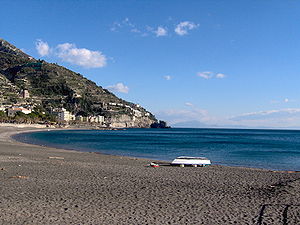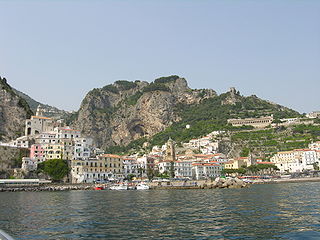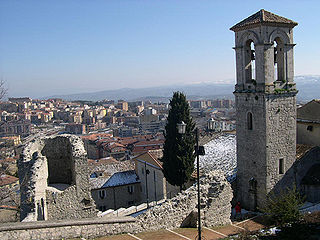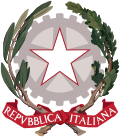As Southern Italy or Mezzogiorno (The expression stands for "noon" in German, is used very similarly to the French "Midi") are the regions in the south Italy designated. In a narrower sense, the term includes the regions of Campania, Basilicata, Calabria, Apulia and Molise. With the expanded definition, the large islands of Sardinia and Sicily as well as some provinces in the north, Abruzzo and parts of Lazium are also included in the Mezzogiorno.
Regions

- Apulia (Italian Puglia) - the "heel" of the boot
- Basilicata (Italian Basilicata)
- Calabria (Calabria) - the "tip" of the boot
- Campania (Campania) - the region around Naples, Vesuvius and the Gulf of Salerno
- Molise - the least known of the regions.
Depending on the design, Sardinia and Sicily included.

places
In the region Apulia, which extends on the southern Adriatic, the "heel" of the Italian boot:
- 1 Bari
 - Capital Apulia
- Capital Apulia - 2 Lecce
 - Provincial capital of the southern Salento peninsula
- Provincial capital of the southern Salento peninsula - 3 Tarent
 - on the Ionian Sea
- on the Ionian Sea
In the region Basilicata, the predominantly mountainous, little-traveled province with only small parts of the coast on the Ionian and Tyrrhenian Seas:
- 4 Potenza
 - Capital of the region Basilicata
- Capital of the region Basilicata - 5 Matera
 - City of the cave dwellings "Sassi"
- City of the cave dwellings "Sassi"
In the region Calabriawhich includes the area of the "toe of the boot" of Italy
- 6 Catanzaro
 - Capital Calabria
- Capital Calabria - 7 Tropea
 - Port town, near the Capo Vaticano
- Port town, near the Capo Vaticano
In the region Campania, the area around the city of Naples and the offshore islands
- 8 Naples
 (Napoli) - Big city, located near the archaeological sites of Herculaneum and Pompeii
(Napoli) - Big city, located near the archaeological sites of Herculaneum and Pompeii - 9 Caserta
 - Baroque royal palace
- Baroque royal palace - 10 Salerno
 - Archbishopric and university town. 1943 Allied landing site
- Archbishopric and university town. 1943 Allied landing site - 11 Amalfi
 and the island off the headland capri
and the island off the headland capri
In Molise:
- 12 Campobasso
 - Capital of Molise.
- Capital of Molise.
background

The southern Italian regions, which for the Mezzogiorno include, roughly speaking, the provinces of the Kingdom of the Two Sicilieswhich was ruled from Naples under the Bourbons. In 1861 it was united with the regions of Upper and Central Italy to form a common nation-state. However, significant differences in cultural, economic and social aspects can still be identified today.
Southern Italy was already settled in prehistoric times, for which numerous witnesses can still be found. In antiquity, the region was from the 8th century. colonized by the Greeks and numerous competing city-states were formed; Magna Graecia ("Greater Greece") retained its culture and the Greek language for a long time, even after the region had been conquered by the Roman Empire, later at least the southern provinces came back to the Byzantine Empire and back into the catchment area after the invasions of the Visigoths and Lombards Greek culture.
After the displacement of the Saracen conquerors, the Normans conquered the south of Italy under Roger I d'Hauteville, followed by Roger II, in 1140 Kingdom of the Two Sicilies founded with the capital Naples. After a short reign of the Stauffer under Friedrich II in the 12th century. After the death of Frederick, the Angiovinians rule in the kingdom conquered by Charles I of Anjou. In the 15th century they defeated the Spanish rulers of the House of Anjou and the throne of the Vice Kingdom of Naples went to the House of Aragon. After the War of the Spanish Succession, rule over the Kingdom of the Two Sicilies passed to the House of Burbon. The Burbons ruled over the kingdom until the irregulars under Giuseppe Garibaldi conquered Naples after the conquest of Sicily; In a plebiscite, the Neapolitans decided to join the Kingdom of Italy, which means that the south of the Italian Peninsula has only belonged to Italy since 1861. Without this decision, the Neapolitan pizza would probably not be an Italian specialty today.
Soon after the integration into the Kingdom of Italy, the previously industrially advanced south lost touch with the arming north, after just a few years the Mezzogiorno became an economically disadvantaged region and, despite economic support from the north, has not been able to connect to this day. The history of large landowners and rural feudal structures, lack of mineral resources and reliance on little heavy industry, nepotism in politics and probably unfavorable influence and withdrawal of economic power through activities of organized crime meant that the Mezzogiorno is still considered a redevelopment case today - but stayed here Much of primeval Italy has been preserved. Globalization has so far passed the province in Apulia and Calabria, even if the mobile phone "Telefonino" is present everywhere, the rhythm of the south beats more leisurely, people take time to get together and the "siesta" is not only during the hot summer months Fall asleep in the afternoon for all activities. In the evening the shops and pubs open and the corso fills up, there is no parking space anymore and life pulsates.
language
Is spoken Italian with various local dialects that are very different from standard Italian. It is even controversial whether Neapolitan and Sicilian are still dialects or already independent languages. Only in a few places in the south of Apulia (the "heel" of the boot) and in the southernmost tip of Calabria (at the "tip of the boot") is still Griko, spoken a dialect enriched with ancient Greek. There is also about the whole Mezzogiorno scattered around 80,000 Arbëreshwho speak an ancient form of Albanian.
English skills are poor in the older population, but young people use English expressions fluently. However, due to the large number of guest workers who have returned to the south from Switzerland or Germany, it is not uncommon to find someone who speaks fair German, even in villages.
getting there

Because of the long journey, many choose this plane as the fastest means of transport to the south. The largest international airports are the airports 1 Naples(IATA: NAP) in Campania, 2 Lamezia-Terme(IATA: SUF) in Calabria and 3 Bari(IATA: BRI) or the 4 Brindisi airport(IATA: BDS) in Puglia.
With the railroad We recommend using the high-speed trains Frecceto get to the south. The Red Frecciarossa ("Red Arrow") connects the north of Italy with two trunk lines along the coasts of the Tyrrhenian Sea and the Adriatic Rome - Naples to Salerno and over Ancona - Pescara to Bari. The Frecciargento The silver-colored high-speed trains run on high-speed and conventional routes to the south Reggio di Calabria and Lecce. The express trains of the Frecciabianca connect large and medium-sized Italian cities between 6 a.m. and 9 p.m., sometimes at hourly and half-hourly intervals. The tickets can be purchased on the website of Trenitalia can be booked online, there is also electronic timetable information.
Long-distance buses operate between numerous major cities in Europe and southern Italian major and even provincial cities. A wide variety of companies offer journeys at sometimes considerably lower rates; As a rule, fellow travelers are "picked up" in some German cities and then driven through the night until the bus drives to some cities in the same province the following day. Since the long-distance buses are often operated by local bus companies and there is no central bus timetable information, it is best to search the Internet using the keywords "starting point", "destination" and "autobus" or "Pullman" (as a term for long-distance bus).
With the Private vehicle the journey to the south is long, starting at the Swiss border Basel or Schaffhausen must go to the end of the toll motorway Naples shortly before Salerno 12 driving hours can be expected from the Swiss border Chiasso with a good nine hours. In addition to the cost of the vignette for the Swiss motorway, you have to reckon with Italian motorway tolls of 60 - 65 euros. From the paying agent Salerno the use of the motorway to Calabria is then free of charge, from there to Reggio di Calabria a further five hours of driving can be expected.
Along the west coast Italy is used from the greater area Milan (Risk of congestion) the ![]() , shortly before Bologna Branch to Florence; Rome and then Naples can easily be bypassed over a wide area. After bypassing Naples on the
, shortly before Bologna Branch to Florence; Rome and then Naples can easily be bypassed over a wide area. After bypassing Naples on the ![]() you use the
you use the ![]() through Campania, it climbs through the mountains (and becomes narrower, slower to drive), after a low plain that opens to the Ionian Sea, past Cosenza Another mountainous passage with tunnels follows, the strait at Lamezia-Terme and another stretch of coast with tunnels and viaducts under renovation until one Reggio di Calabria reached.
through Campania, it climbs through the mountains (and becomes narrower, slower to drive), after a low plain that opens to the Ionian Sea, past Cosenza Another mountainous passage with tunnels follows, the strait at Lamezia-Terme and another stretch of coast with tunnels and viaducts under renovation until one Reggio di Calabria reached.
Around along the Adriatic coast to Apulia To get there, one drives around Bologna, it goes south on the ![]() past Rimini (risk of traffic jams during the holiday season), Ancona and then also less traveled straight motorway stretches up Bari, the freeway then crosses over to Tarent to the Ionian Sea. Down to Brindisi and the Salento peninsula leads the developed as an expressway
past Rimini (risk of traffic jams during the holiday season), Ancona and then also less traveled straight motorway stretches up Bari, the freeway then crosses over to Tarent to the Ionian Sea. Down to Brindisi and the Salento peninsula leads the developed as an expressway ![]() 'You won't find any highways here in the south. From Chiasso to Brindisi you have to reckon with a journey time of 11-12 hours.
'You won't find any highways here in the south. From Chiasso to Brindisi you have to reckon with a journey time of 11-12 hours.
The regions between the main axes are relatively poorly developed, especially the Basilicata, on the main roads Strada Statale Because the traffic is often not free of intersections, it is not possible to move forward too quickly, even if most cities are now bypassed. In the mountainous regions in southern Italy, fog and slippery ice must be expected in the winter months, so that in some cases winter tires are mandatory and it is mandatory to carry snow chains between November and March.
mobility

Public transport is developed very differently in the south of Italy. In addition to the High speed trains the Frecce the regional train network is comparatively thin, the train density is low and the costs and comfort of the trains are similarly low. On the website of the Trenitalia electronic timetable information can be used. In Puglia south of Lecce Trains and buses operate the Ferrovie del Sud Est, in the Basilicata the trains of Ferrovie Appulo Lucane, Trenitalia is active in Calabria.
A pronounced dense bus network also supplies smaller towns, as the bus routes are largely organized by private companies, run in a star shape from the company headquarters to the surrounding towns and there is no uniform website for electronic timetable information, it is a challenge to find the right bus schedule and the right departure stop Find. Long-distance buses run from provincial towns to the Italian metropolises, Naples, Rome and Milan are approached from most of the larger cities, but in "inland" traffic from one terminal to the next, no regional traffic passengers are taken.
So there is often only that left to reach smaller towns and national parks Private vehicle, the rental car or the rented scooter. The road traffic often looks a bit chaotic, but it is more lively; Attention is required from all road users (including pedestrians), after a little getting used to it is safe to drive even in southern Italy (see notes in the country article Italy). Be careful drivers of Mobile homes Recommended when driving through town, with larger vehicles it is better to use the often signposted route for trucks over 3.5 t in order not to get stuck in a narrow point. Old town streets were planned by donkey carts and, at best, the Cinque Cento and are not passable for wide vehicles (mostly signposted), if you park a little outside the center of the village and walk, you do not risk damage to the paintwork.
Tourist Attractions
.jpg/220px-Paestum_ruins_(6120346389).jpg)
.jpg/220px-Hera_Temple_at_Metaponto_(Italy).jpg)
- the whole south of Italy is rich in archaeological sites from Greek and Roman times: the probably most beautiful preserved Greek temples on the mainland stand by Paestum in Campania, among the ruins from Roman times in Campania are Pompeii and Herculaneum the most popular.
- Due to the eventful history, there is a fortress from Norman times or a fortress of the Angioviner or Aragonese in almost every town
- The baroque churches are countless with works by well-known and less well-known painters and sculptors
- the seaside resorts on the Amalfi Coast and the islands capri and Ischia can only be described as quiet in the off-season.
- The national parks in the mountainous regions are mainly visited by locals Basilicata and Calabria.
activities


- the beaches on the coasts of the Tyrrhenian Sea in the west and the Adriatic Sea in the east are partly steep rocky with idyllic bays, partly sandy; on the Ionian Sea (in the "arches" of the "Italian boot" there are mainly gently sloping sandy beaches.
- to the hike invite the national parks in Basilicata and Calabria. A number of hiking trails are marked, unfortunately there are hardly any current topographical maps for the whole of southern Italy, so that hikes often have to be planned with route descriptions and online maps.
- increasingly wins Cycle tourism in importance, along the plane of the Cilento For example, cycle paths were created which are completely absent in the interior of Basilicata. There you have to use the winding private roads with little car traffic.
- paddling rivers and lakes are rare with that Sea kayak coastal tours can be planned. It is less strenuous with the rented motorboat.
kitchen
.jpg/220px-La_vera_pizza_Napolitana_(319020748).jpg)
- the Pizza is actually a typical southern Italian specialty, even if it is associated with Italian cuisine today - around Naples with tomatoes, basil and buffalo mozarella.
- The relevant articles provide information on regional specialties
- Specialties are the Calabrian nduja sausages, spicy salami with peperoncini, which gives it a characteristic orange-red color. In Campania, more precisely in Cilento the real buffalo mozzarella is produced ("Mozzarella di bufala").
- Fish specialties are almost only offered in port cities; in provincial cities 30 or 50 km from the coast, dried meat, salami and hard cheese are served alongside olives antipasti enough.
- Gelati can be found almost everywhere on Corso, in the Cono (Waffle) and in a cup - ice cream specialties originally came from Sicily.
nightlife
- Shops and bars only open after the siesta has ended, and food is not served until late, from 8 p.m. to 9 p.m.
- then you meet on the Corso, strolls on the main street, enjoys gelati, a seeing and being seen.
- later, at least where the old town is not closed to motorized traffic, the youngsters and the young at heart drive up and down the corso with anything with an engine, mopeds, scooters, motorcycles and cars (preferably open and with loud music), which doesn’t let anyone sleep who has booked his hotel room on the main street and wants to leave early the next morning.
- the bars are open well into the night, it is often noisy, but drunkenness in public is not welcome (even if you turn a blind eye to tourists who bring in foreign currency, the reputation does not improve).
- large discos are often outside the cities and can only be visited with a private vehicle.
- for the lavish family celebrations and weddings with hundreds of guests there are suitable places outside the village in beautiful places, called "Sala di Ricevimento". Individual guests can usually not stop here, even if, due to the large number of cars, one initially thinks that they are standing in front of a well-frequented restaurant.
security
- Despite its bad reputation in the past, life in southern Italy is no more dangerous than the rest of western Europe. As in practically all other large cities and tourist centers, the bulging wallet should not stick out of the back pocket, the expensive camera should not be left on the passenger seat during a city tour (in the age of the cell phone, single-lens reflex and video cameras are less popular as status symbols and bring the thief to life when selling less one). The days when the Italians went for a walk with the car radio in hand are over with the spread of the standard built-in car radio and the iPod.
- Car thieves know about alarm systems and immobilizers; The fact that expensive vehicles and rental cars can be located using GPS did not go unnoticed by car thieves.
- Begging Roma children and scroungers who "rent" public parking spaces are more a part of the street scene. Not all beggars are real Italians, I remember fondly the old man with the cardboard sign "ho fame" (I'm hungry), who responded to a German remark with an equally German "Shut up." However, real poverty is still part of everyday life in the Italian south, the earning opportunities are often low except in tourism, agriculture and small businesses, so that customers are welcome at the stand with honey, cheese or vegetables from their own production.
- with the organized crime the tourist practically does not come into contact, the "Mafia" and the southern Italian parallel organizations have no interest in scaring off the tourists who bring money into the country and have resorted to channeling subsidies flowing into the south into the right hands and companies.
- Danger is more imminent Road trafficif you cross the street at the zebra crossing without thinking (seek eye contact) or overestimate your own driving skills with the rented scooter.
- the climatic conditions are different, in the summer heat you have to watch out for fluid loss (usually, and if not labeled as Acqua non potabile ", tap water is of drinking water quality throughout), sunburns characterize vacationers from the north and sun cream is only part of the usual range in the midsummer months the supermarkets.
climate
The Mediterranean climate makes spring - early summer and autumn the most pleasant months to travel. In midsummer, the climate with temperatures around 30 - 38 ° C in the shade is often difficult to bear for travelers from German-speaking countries, in Italy you take a siesta in the hot afternoon hours and only go to the beach or the streets of the city in the evening.



.JPG/320px-Castello_Aragonese(Taranto).JPG)













